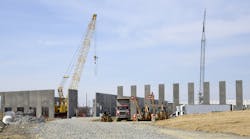The industrial real estate (IRE) market may be losing some steam, but its remarkably consistent growth in 2022 supports a forecast of continued strength in spite of economic softening, predicts global real estate giant Cushman & Wakefield (C&W).
Throughout 2023, supply should continue to outpace demand as the development pipeline remains robust, with the majority of developments anticipated to deliver in 2023, the company says.
“With much of the space being built on a speculative basis, there is a risk of overbuilding in certain markets in the near-term,” C&W warns in a recent look at the past year and what the future holds. “In the face of an increasingly difficult economic climate and the Fed pursuing additional hike rates, we anticipate construction starts to slow down.”
Overall tenant demand should remain positive, it adds, “but it can be expected to continue to decelerate as choppier economic conditions emerge and consumer spending continues to rotate back towards services.”
The upshot is that some IRE tenants may choose to opt for a wait-and-see approach during this year due to a prolonged period of economic uncertainty, while other companies who enjoy continuing growth may find new opportunities to expand their footprints as a more consistently reliable supply delivers vacancies in some cases.
The industrial market in the United States finished 2022 with its second highest total for overall net absorption on record at 477.3 million square feet (msf), coming in just behind the 561.4 msf registered in 2021, C&W reports.
It is not surprising that C&W’s analysis closely tracks those by other prominent IRE firms, like JLL, Prologis and CBRE. They also are aware of many of the same economic conditions as well as the factors impacting how customers choose warehouse and distribution center (DC) space.
It is common knowledge that nervous shippers of all kinds continue to believe in the need to build and maintain safety stocks. Although a rail strike was averted at the last minute late in 2022, rail freight service remains unreliable, the truck driver shortage persists, and although port congestion has eased back to normal levels, contract talks over a new West Coast longshoremen’s contract are bogged down and are making shippers nervous.
Ken Simonsen, chief economist of the Associated General Contractors of America, sees a stronger housing market developing, along with the construction of new manufacturing capacity, including more announcements of gigantic factory projects that began last year and continued in January.
However, C&W holds that in 2022, slowing demand amid economic headwinds, coupled with historically tight market conditions, pushed the fourth quarter total to 107.3 msf, which was down 9.4% from the third quarter. “Still, this marked the ninth straight quarter in which absorption surpassed the 100-msf mark and indicates that demand for industrial space remains strong going into the new year,” the company points out.
Where It’s Being Built
Of the 81 markets C&W tracks, 19 recorded more than 2.0 msf of net absorption in the fourth quarter while another nine exceeded 1.0 msf. While absorption finished in the red in just eight markets at the close of the fourth quarter—with most posting nominal net losses—the company said this is an improvement from the previous two quarters when 10 markets, on average, yielded negative absorption.
For the third year in a row, the U.S. industrial market inked more than 700 msf of new leasing volume, with 757 msf signed throughout 2022. This was the second-best year in history, only lagging the 923 msf in 2021.
Although e-commerce transactions fell in comparison to 2020 and 2021, other industries propelled demand totals during 2022. Strong activity by retailers, wholesalers, third-party logistics (3PLs) and manufacturing companies drove another healthy quarter of leasing, the report notes.
“That said, tenant demand began to tick lower in the second half of 2022 as some tenants began to tap the brakes amid the uncertainty around the economy and a deceleration in consumer spending on goods,” C&W explains.
In the fourth quarter, gross industrial leasing declined by 28% quarter-over-quarter (QoQ) and by 37% year-over-year (YoY). The company adds: “Although these declines are coming off peak levels of activity, it’s a trend we are watching as we head into 2023. Dallas/Fort Worth (13.8 msf), Houston (9.2 msf), Atlanta (8.1 msf), and Phoenix (7.0 msf) were the most active markets throughout the fourth quarter.”
New deliveries remained elevated in the fourth quarter as 143.6 msf of industrial product completed construction, just 5.2% behind the pace set during the third quarter of 2022. As a result, supply outpaced demand for the second straight quarter and on an annual basis.
The company also points to the South’s strength. Regionally, the southern states represented almost half of the square feet absorbed throughout the fourth quarter, despite accounting for just one-third of the nation’s inventory.
The South region, led by Atlanta, Dallas/Fort Worth, Houston, and Louisville, yielded a robust delivery total of 70.3 msf during the fourth quarter and made up 49.0% of the U.S. total. New completions totaled 495 msf for all of 2022, which C&W says is a new high.
The South was the primary contributor to the development pipeline, with more than 316 msf being constructed at year-end, accounting for 46.4% of the national total. Of the 17 markets boasting pipelines of over 10.0 msf, eight reside in the South and four are in the Midwest.
What’s Fueling Growth
Although the industrial construction pipeline remains robust with 682 msf in the works for 2023, it is beginning to show early signs of pulling back. Construction starts fell during the fourth quarter of 2022 as some developers opted to delay groundbreakings due to economic headwinds and as the financing of some projects became tougher to secure.
“However, with strong fundamentals and tight vacancy rates persisting across the country, 83% of the product under construction are speculative, of which 21.3% has been pre-leased by tenants,” C&W says. “With most of the total slated to deliver throughout 2023, it will likely push the overall vacancy rate higher over the next few quarters.”
Amid another quarter of healthy construction deliveries coupled with tempered deal activity, the U.S. industrial vacancy rate ticked up to 3.3%—20 basis points (bps) higher than the prior quarter. Despite the uptick, vacancy is still 140 bps lower than it was before the pandemic and remains more than 300 bps lower than its 10-year average of 6.5%.
The West (2.6%) and Northeast (3.2%) boasted the lowest vacancy rates with their port-proximate industrial markets, including Los Angeles, Savannah, northern New Jersey, and Charleston, which are among the tightest in the nation. “In fact, 12 markets registered vacancy rates of 2.0% or lower at year-end,” C&W reported. “Meanwhile, vacant sublease space ticked higher, albeit nominally since midyear, with the national sublease vacancy rate ending 2022 at 0.2%.”
Asking rents for industrial space soared in 2022 but have shown signs of moderating in recent quarters, the company also notes. In the fourth quarter, the average industrial asking rental rate climbed only 1.0% QoQ to $8.81 per square foot (psf) but swelled by 18.6% YoY, marking the strongest year in history for annual rental rate growth.
Meanwhile, within warehouse/distribution facilities, the key driver of the industrial market, asking rents surged by 21.6% annually (but only 0.6% QoQ). Just five of the 81 markets tracked yielded double-digit quarterly increases while 24 markets recorded YoY growth rates of 20% or higher, C&W said.
To be more specific, Charleston, Inland Empire, Phoenix, and Miami all recorded annual gains of 40% or higher. C&W also observes that coastal and port/population-proximate markets continued to be priced at a premium over the rest of the country with nine of the 10 highest priced warehouse markets concentrated within California and New York/New Jersey.
As a result, the company also believes that we can expect the overall vacancy rate to trend higher in 2023 as the strong construction pipeline delivers into a weaker economy.
“For a sector that has been undersupplied for years, this is much needed development to bring supply and demand into better balance. Despite the rise in vacancy, the market will remain tight in 2023 causing rents to continue to appreciate in the high single digits.”
As for what lies ahead beyond this year, the company currently is predicting that in 2024, supply will finally catch up, at which point rent growth will likely moderate back into the 3% range.



